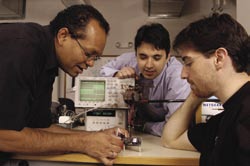As he programs silicone microcircuits to mimic sensory systems, Ralph Etienne-Cummings keeps his eye on the lamprey eel and the fly.

In search of inspiration for more sophisticated, more energy-efficient, and ever-smaller sensory systems to serve as the eyes, legs, and ears of next-generation robots, Ralph Etienne-Cummings and his colleagues continually look to nature. They peer into the eye of Diptera, so to speak, or along the spinal cord of the lamprey eel.
In his view, a fly is anything but lowly. “Here is a tiny insect with an extremely sophisticated system of sight that allows it to fly around a room, avoid slaps and flyswatters, and even mate in midair,” says Etienne-Cummings, “yet it uses less than one grain of sugar’s worth of energy a day.”
A pioneer in the field of neuromorphic engineering, Etienne-Cummings is an associate professor of Electrical and Compu-ter Engineering and director of the Whiting School of Engineering’s Computational Sensory-Motor Systems Laboratory. Working in the Whiting School’s renovated Stieff Silver building, near the Homewood campus, his research team explores the crossroads of microcircuitry and biological systems, particularly sensory perception systems. “There are very similar constraints in the way biology works and the way microcircuits work,” he explains. “Knowing this, we can construct microcircuits that look a lot like biological systems.”
Microcircuits are hardly new. These tiny, 4mm square wafers of staggering computing power have become ubiquitous in computers, digital cameras, and mobile phones. They teach cars to tune themselves, and every second globally route billions of e-mail messages.
What is new is programming the ultra-small, ultra-fast, and ultra-efficient silicon microcircuits to mimic biological functions. In his lab, Etienne-Cummings and several graduate students demonstrate just how sensitive some of these sensory systems have become.
On the bench is an experiment exploring the viability of a single chip stereo visual system. It would replace the bulky, analog cameras currently installed on robots to provide visual depth perception. It would do so at a fraction of the size and using a fraction of the energy.
Across the way is a chip-based camera with a shape recognition engine that can be taught to “deconstruct” an image into its hue, saturation, and intensity, mimicking the way the human eye senses color and shape. The chip-based camera can then store shape templates for later reference and recognition, in effect, a kind of “seeing is believing” intelligence. This technology, developed on a Small Business Innovation Research award to Iguana Robotics, Inc., has applications in interactive toys and aids for the blind.
The Next Step: Treating Spinal Cord Injuries

As they study the spinal cord of the lamprey eel to better understand how to make robots stand, walk, and run, Etienne-Cummings, his colleagues, and researchers at the University of Maryland also are discovering new ways to treat spinal cord injuries in humans. “The spinal cord is actually part of the brain,” he explains. “All the memory, all of the learned structures for walking are in it, even if connections to the cerebral cortex have been severed.” Those learned structures operate like an oscillating circuit, or central pattern generator, which fires neurons in an alternating pattern essential to modulating such actions as walking, swinging arms, and running. The lab’s research team has constructed walking robots with microcircuitry that mimics the central pattern generators found in the human spinal cord.

The researchers have “taught” these robots to walk, stride, run, march, and even to produce a strutting gait they whimsically call “night on the town.” To aid patients suffering from spinal cord injuries, the researchers envision implantable stimulators that could fire the oscillating circuits of the spinal cord below a break to stimulate movement and, eventually, help facilitate walking.
Creating experimental microcircuits designed on sophisticated, industry-standard software platforms can be expensive. Once a design is complete, it is sent via file transfer protocol (FTP) from the lab to the chip manufacturer. To keep costs down, manufacturers gang many academic projects into single “jobs” and create their chips together. Each chip manufactured this way can cost around $12,000. Compare that to the upwards of $1 million for a single chip that a major technology company might spend. “So you can see,” Etienne-Cummings observes, “the corporate world would prefer us to experiment.”
The Johns Hopkins University, says Etienne-Cummings, is the perfect place to conduct his inherently interdisciplinary approach to research. Working with the Engineering Research Center for Computer-Integrated Surgical Systems and Technology (ERCCISST), a collaborative inter-university project funded by the National Science Foundation and hosted by Hopkins, he is exploring ways to “improve the delivery of surgery, and how to give the surgeon information dynamically.” The researchers build sensors that can serve as track tools to assess how well a surgeon is doing. “Hopkins has people who were there at the beginning of the neuromorphic engineering explosion,” he says, “and of course, Hopkins has the benefit of a top-ranked medical school.”

From Beach to Bench : A native of the Seychelles, an archipelago northwest of Madagascar, Ralph Etienne-Cummings describes his homeland affectionately as the “Caribbean of Europe.” Even in paradise, science and engineering were on the young man’s mind. “Perhaps because the only way to get to and away from the Seychelles was by boat or plane,” he explains, “my friends and I were very interested in flight.” At one time, he even toyed with the idea of pursuing aeronautical engineering. After attending boarding school in England, Etienne-Cummings at age 18 came to America with his mother and father. As a physics major at Lincoln University in Pennsylvania, he learned how transistors work, and then went on to the University of Pennsylvania to study engineering. In 1995, he received his PhD from Penn, with a special interest in integrated circuits. He joined the Whiting School of Engineering in 1998. This June 2003 photo shows some of the reasons he enjoys returning to the Seychelles for a visit.
To see more of Ralph Etienne-Cumming’s research projects, including a movie of a running robot, go to etienne.ece.jhu.edu/~etienne/ .




